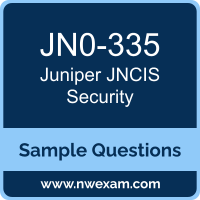01. What is a critical step in configuring application security?
a) Setting up default login credentials.
b) Disabling all firewall settings.
c) Implementing strong, multi-factor authentication mechanisms.
d) Avoiding regular software updates.
02. A client has attempted communication with a known command-and-control server and it has reached the configured threat level threshold. Which feed will the client's IP address be automatically added in this situation?
a) the command-and-control cloud feed
b) the allowlist and blocklist feed
c) the custom cloud feed
d) the infected host cloud feed
03. You are asked to implement IPS on your SRX Series device. In this scenario, which two tasks must be completed before a configuration will work?
(Choose two.)
a) Download the IPS signature database.
b) Enroll the SRX Series device with Juniper ATP Cloud.
c) Install the IPS signature database.
d) Reboot the SRX Series device.
04. How does Advanced Policy-Based Routing (APBR) contribute to application security?
a) By ensuring data is encrypted when transmitted between applications.
b) By redirecting traffic based on application-specific policies and security needs.
c) By blocking all external application traffic.
d) By automatically updating applications.
05. Which method does the IoT Security feature use to identify traffic sourced from IoT devices?
a) The SRX Series device streams metadata from the IoT device transit traffic to Juniper ATP Cloud.
b) The SRX Series device streams transit traffic received from the IoT device to Juniper ATP Cloud.
c) The SRX Series device identifies IoT devices using their MAC addresses.
d) The SRX Series device identifies IoT devices from metadata extracted from their transit traffic.
06. Regarding static attack object groups, which two statements are true?
(Choose two.)
a) Matching attack objects are automatically added to a custom group.
b) Group membership automatically changes when Juniper updates the IPS signature database.
c) Group membership does not automatically change when Juniper updates the IPS signature database.
d) You must manually add matching attack objects to a custom group.
07. When a security policy is deleted, which statement is correct about the default behavior for active sessions allowed by that policy?
a) The active sessions allowed by the policy will be dropped.
b) The active sessions allowed by the policy will be marked as a legacy flow and will continue to be forwarded.
c) The active sessions allowed by the policy will be reevaluated by the cached policy rules.
d) The active sessions allowed by the policy will continue unchanged.
08. Which three statements are true when working with SRX chassis clusters?
(Choose three.)
a) The valid cluster-id range is between 0 and 255.
b) SRX Series devices can belong to more than one cluster if cluster virtualization is enabled.
c) If the cluster-id is set to 0 on an SRX Series device, the device will not participate in the cluster.
d) A reboot is required if the cluster-id value or node value is changed.
e) SRX Series devices can belong to one cluster only.
09. In application QoS, which factor is critical in determining traffic prioritization?
a) The size of the application.
b) The geographic location of the user.
c) The type of service the application is providing.
d) The color scheme of the application interface.
10. You are asked to find systems running applications that increase the risks on your network. You must ensure these systems are processed through IPS and Juniper ATP Cloud for malware and virus protection.
Which Juniper Networks solution will accomplish this task?
a) Adaptive Threat Profiling
b) UTM
c) Encrypted Traffic Insights
d) JIMS
 Before you write the Juniper JNCIS Security (JN0-335) certification exam, you may have certain doubts in your mind regarding the pattern of the test, the types of questions asked in it, the difficulty level of the questions and time required to complete the questions. These Juniper Networks Certified Specialist Security (JNCIS-SEC) sample questions and demo exam help you in removing these doubts and prepare you to take the test.
Before you write the Juniper JNCIS Security (JN0-335) certification exam, you may have certain doubts in your mind regarding the pattern of the test, the types of questions asked in it, the difficulty level of the questions and time required to complete the questions. These Juniper Networks Certified Specialist Security (JNCIS-SEC) sample questions and demo exam help you in removing these doubts and prepare you to take the test.